Samsung SRD-440 User Manual

4 CHANNEL DVR
User Manual
SRD-440

4 Channel DVR
User Manual
Copyright
©2011 Samsung Techwin Co., Ltd. All rights reserved.
Trademark






 is the registered logo of Samsung Techwin Co., Ltd.
is the registered logo of Samsung Techwin Co., Ltd.
The name of this product is the registered trademark of Samsung Techwin Co., Ltd.
Other trademarks mentioned in this manual are the registered trademark of their respective company.
Restriction
Samsung Techwin Co., Ltd shall reserve the copyright of this document. Under no circumstances, this document shall be reproduced, distributed or changed, partially or wholly, without formal authorization of Samsung Techwin.
Disclaimer
Samsung Techwin makes the best to verify the integrity and correctness of the contents in this document, but no formal guarantee shall be provided. Use of this document and the subsequent results shall be entirely on the user’s own responsibility. Samsung Techwin reserves the right to change the contents of this document without prior notice.
Warranty
If the product does not operate properly in normal conditions, please let us know. Samsung Techwin will resolve the problem for free of charge. The warranty period is 3 years. However, the followings are excluded:
•Data loss due to a damaged hard disk
•If the system behaves abnormally because you run a program irrelevant to the system operation.
•Data loss due to virus infection
•Deteriorated performance or natural worn-out in process of time
•Sensory phenomenon that does not affect the performance or quality of the product (ex: working noise).
Design and specifications are subject to change without prior notice.
The default password can be exposed to a hacking thread so it is recommended to change the password after installing the product.
Note that the security and other related issues caused by the unchanged password shall be responsible for the user.
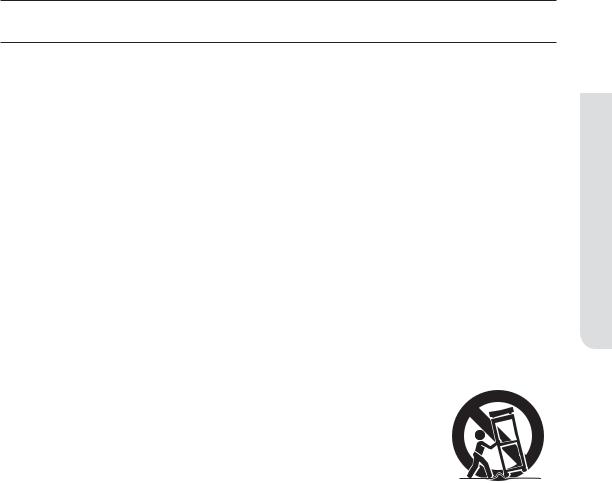
overview
IMPORTANT SAFETY INSTRUCTIONS
Read these operating instructions carefully before using the unit.
Follow all the safety instructions listed below.
Keep these operating instructions handy for future reference.
1) |
Read these instructions. |
|
|
2) |
Keep these instructions. |
OVERVIEW |
|
3) |
Heed all warnings. |
|
|
|
|
||
4) |
Follow all instructions. |
|
|
5) |
Do not use this apparatus near water. |
|
|
6) |
Clean only with dry cloth. |
|
|
7) |
Do not block any ventilation openings, Install in accordance with the manufacturer’s instructions. |
|
|
8) |
Do not install near any heat sources such as radiators, heat registers, stoves, or other |
|
|
|
apparatus (including amplifiers) that produce heat. |
|
|
9) |
Do not defeat the safety purpose of the polarized or groundingtype plug. A polarized plug has |
|
|
|
two blades with one wider than the other. A grounding type plug has two blades and a third |
|
|
|
grounding prong. The wide blade or the third prong are provided for your safety. if the provided |
|
|
|
plug does not fit into your outlet, consult an electrician for replacement of the obsolete outlet. |
|
|
10) |
Protect the power cord from being walked on or pinched particularly at plugs, convenience |
|
|
|
receptacles, and the point where they exit from the apparatus. |
|
|
11) |
Only use attachments/accessories specified by the manufacturer. |
|
|
12) |
Use only with the cart, stand, tripod, bracket, or table specified by the |
|
|
|
manufacturer, or sold with the apparatus. When a cart is used, use |
|
|
|
caution when moving the cart/apparatus combination to avoid injury from |
|
|
|
tip-over. |
|
|
13) |
Unplug this apparatus during lightning storms or when unused for long |
|
|
|
periods of time. |
|
|
14) |
Refer all servicing to qualified service personnel. Servicing is required when the apparatus has |
|
|
|
been damaged in any way, such as power-supply cord or plug is damaged, liquid has been |
|
|
|
spilled or objects have fallen into the apparatus, the apparatus has been exposed to rain or |
|
|
|
moisture, does not operate normally, or has been dropped. |
|
|
English _3

overview
BEFORE START
This user manual provides Information for using the DVR such as brief introduction, part names, functions, connection to other equipment, menu setup, etc.
You have to keep in mind the following notices :
•SAMSUNG retains the copyright on this manual.
•This manual cannot be copied without SAMSUNG’s prior written approval.
•We are not liable for any or all losses to the product incurred by your use of non-standard product or violation of instructions mentioned in this manual.
•Prior to opening the case, please consult a qualified technician first. Whenever this is needed power must be removed from the unit.
•Before installing an additional HDD or connecting an external storage device (USB memory or USB HDD) to this DVR, check the compatibility. Consult your provider for the compatibility list.
Warning
Battery
It is essential that when changing the battery in the unit, the replacement battery must be of the same type otherwise there may be a possibility of an explosion.
The following are the specifications of the battery you are using now.
• Normal voltage : 3V
• Normal capacity : 170mAh
• Continuous standard load : 0.2mA
• Operating temperature : -20°C ~ +85°C (-4°F ~ +185°F)
JConnect the power cord into a grounded outlet.
The Mains plug is used as a disconnect device and shall stay readily operable at any time.
Batteries shall not be exposed to excessive heat such as sunshine, fire or the like.
System Shutdown
Turning off the power while the product is in operation, or undertaking improper actions may cause damage or malfunction to the hard drive or the product.
Please turn off the power using the Power button on the front of your DVR. After selecting <OK> in the pop-up menu, you can pull off the power cord.
You may want to install a UPS system for safe operation in order to prevent damage caused by an unexpected power stoppage. (Any questions concerning UPS, consult your UPS retailer.)
Operating Temperature
The guaranteed operating temperature range of this product is 0°C ~ 40°C (32°F ~ 104°F).
This product may not work properly if you run right after a long period of storage at a temperature below the guaranteed one.
Prior to using a device that has been stored for a long period in low temperatures, allow the product to stand at room temperature for a period.
Especially for the built-in HDD in the product, its guaranteed temperature range is 5°C ~ 55°C (41°F ~ 131°F). Likewise, the hard drive may not work at a temperature below the guaranteed one.
4_ overview

CONTENTS
OVERVIEW |
3 |
Important Safety Instructions |
4 |
Before Start |
|
3 |
7 |
Features |
9 |
Part Names and Functions (Front) |
|
10 |
Part Names and Functions (Rear) |
|
|
11 |
Remote Control |
CONNECTING WITH |
12 |
Installation |
OTHER DEVICE |
12 |
Checking the installation environment |
12 |
13 |
Connecting the Video, Audio, and Monitor |
13 |
Connecting the USB |
|
13 |
Connecting POS Device |
|
14 |
Connecting the Alarm Input/Output |
|
|
14 |
Connecting the RS-485 Device |
|
15 |
Connecting the Network |
LIVE |
17 |
Getting Started |
19 |
Live Screen Configuration |
|
17 |
23 |
Live Mode |
25 |
Spot Out |
|
25 |
Zoom |
|
|
26 |
Audio ON/OFF |
|
26 |
Freeze |
|
26 |
Event Monitoring |
USING THE DVR |
28 |
System Setup |
38 |
Setting the Device |
|
28 |
46 |
Setting the Recording |
49 |
Setting the Event |
|
52 |
Backup |
|
|
53 |
Network Configuration |
|
60 |
Controlling a PTZ device |
OVERVIEW
English _5

overview
SEARCH & PLAY |
62 |
Search |
62 |
65 |
Playback |
WEB VIEWER |
67 |
Introducing Web Viewer |
68 |
Connecting Web Viewer |
|
67 |
69 |
Using Live Viewer |
75 |
Using Search Viewer |
|
|
79 |
Viewer Setup |
|
90 |
About |
|
91 |
Mobile Viewer |
BACKUP VIEWER |
92 |
SEC Backup Viewer |
92 |
|
|
APPENDIX |
94 |
Product Specification |
96 |
Product Overview |
|
94 |
97 |
Default Setting |
100 |
Troubleshooting |
|
|
103 |
Open Source License Report on the Product |
6_ overview

FEATURES
The DVR employs H.264 video encoding for 4 channel inputs and audio encoding for 1 channel while simultaneously supports hard disc recording and playback.
These DVRs also supports network connectivity, providing remote monitoring from a remote PC transferring video and audio data.
• Provides a convenient User Interface |
|
|
• Supports CIF(S)/2CIF(M)/4CIF(L) recording formats |
|
|
• With the network specific codec, network transfer enabled regardless of the recording conditions |
|
|
• Hard Disk overwrite function |
OVERVIEW |
|
• De-interlacing processor for better picture quality |
|
|
• Display of HDD information and status by using HDD SMART |
|
|
• Mass storage hard disk backup through high-speed USB 2.0 |
|
|
• Simultaneous Record and Playback of 4 channel video data |
|
|
• Various Search Modes (Time, Event, Backup, Pos, Motion Detection) |
|
|
• Various Recording Modes (Time Lapse, Event, Scheduled Recording) |
|
|
• Alarm Interface |
|
|
• Remote Monitoring function by Network Viewer, Smart Viewer and Mobile Viewer |
|
|
|
|
|
English _7

overview
Standards Approvals
MThis equipment has been tested and found to comply with the limits for a Class A digital device, pursuant to part 15 of the FCC Rules. These limits are designed to provide reasonable protection against harmful interference when the equipment is operated in a commercial environment.
This equipment generates, uses, and can radiate radio frequency energy and, if not installed and used in accordance with the instruction manual, may cause harmful interference to radio communications. Operation of this equipment in a residential area is likely to cause harmful interference in which case the user will be required to correct the
interference at his own expense.
Package Contents
Please unwrap the product, and place the product on a flat place or in the place to be installed. Check if the main unit and all the following accessories are included in the product package.
DIGITAL VIDEO RECORDER SRD-440
DVR |
Adapter |
Power Cable |
Mouse |
Remote Control / Battery (AAA x 2) |
User Manual |
||
|
|
|
|
|
Quick Guide (optional) |
Network Viewer Software |
User Manual CD |
8_ overview

PART NAMES AND FUNCTIONS (FRONT)
DIGITAL VIDEO RECORDER SRD-440
POWER  REC
REC
b c
|
Part Names |
Functions |
|
|
USB Port |
Connects the USB devices. |
|
b |
Remote Control |
Input the remote control signal. |
|
Receiver |
|||
c |
LED Indicator |
Power LED : Displays the power ON/OFF status. |
|
REC : Lights on when recording is in progress. |
|||
|
|
OVERVIEW
English _9

overview
PART NAMES AND FUNCTIONS (REAR)
|
|
b |
c |
|
|
|
|
1 |
2 |
|
AUDIO IN |
|
|
|
NETWORK |
|
|
|
ALARM OUT |
||||
|
|
|
|
|
DC 12 V |
||
|
|
|
|
VGA |
1 COM |
RS-485 |
|
|
|
|
|
ALARM IN |
|
||
|
|
|
|
1 |
2 3 4 G G |
+ |
CONSOLE |
3 |
4 |
|
|
|
|
|
|
|
|
|
|
|
|
||
|
VIDEO IN |
VIDEO OUT (SPOT) |
AUDIO OUT |
SERIAL |
|
|
USB |
|
|
|
|
||||
|
|
|
|
|
|
|
|
Part Names |
|
|
|
Functions |
|
||
VIDEO IN |
Input port for the composite video signal. |
|
|
||||
bVIDEO OUT (SPOT) BNC type of output port for the composite video signal.
c AUDIO IN |
Input ports (RCA jack) for the audio signal. |
|
VGA |
Output port for VGA video signal. |
|
NETWORK |
NETWORK connector port. |
|
DC 12V |
DVR power input port. |
|
USB |
USB connector port. |
|
|
ALARM IN |
1~4, G : Alarm Input port. |
ALARM OUT |
1, COM : Alarm Output port. |
|
|
RS-485 |
Used to establish RS-485 communications. |
SERIAL |
Serial port for connecting to a POS device. |
|
|
AUDIO OUT |
Output port (RCA jack) for the audio signal. |
MIf the VGA cable is connected, the video source from the VGA adaptor will be played as main screen. Then, the [VIDEO OUT] signal will be changed to the Spot signal.
The monitor distributor is not supported.
To play the video from the VGA adaptor properly, the DVR must have set to turn on the VGA monitor.
The man screen is defaulted to [VIDEO OUT]. If you change it to the VGA source, the [VIDEO OUT] source will be changed to the Spot signal.
10_ overview
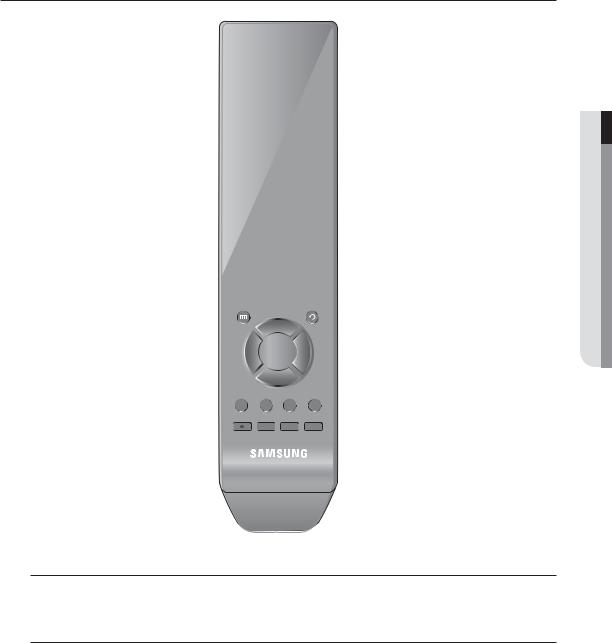
REMOTE CONTROL
SEARCH
Displays the search menu.
MODE 
Changes the screen mode.
POWER
Displays the Exit pop up screen.
NUMBER [0~+10]
Used as the numeric input keys, or displays a single channel.
Skip Backward (by unit time),
Slow Rewind, Slow Forward,
Skip Forward (by unit time)
T/W
Zooms in or out.
MENU
Goes to the system menu screen.
Up/Down/Left/Right(▲▼◄ ►)/ENTER
Moves the cursor up/down/left/right, and runs the
Select Menu.
FREEZE
Freezes the screen temporarily.
ZOOM
Runs the digital zoom (x2) function.
REC
Starts or ends the live recording.
VIEW
Runs the View function in the PTZ mode.
BACKUP
Displays the Backup Menu.
DVR
Activates the DVR function.
ID
Sets the ID of the system.
Select 2 digits from 0 ~ 9 while pressing the ID Key.
Move Frame
While paused, moves to the previous/next frame.
 FR, STOP, PLAY/PAUSE, FF
FR, STOP, PLAY/PAUSE, FF
PTZ
Displays or ends PTZ.
SCROLL ,.
Moves the menu scroll.
RETURN
Returns to the previous screen.
AUDIO
Turns Audio on/off.
ALARM
Cancels the Alarm.
REC LOCK
Selects the recording lock function.
PRESET
Displays the Preset Setup.
OVERVIEW
Using the Numeric buttons
1.Press any button among 1 to 4.
2.Move to the selected channel number.
Changing the Remote Control ID
1.Press the ID button of the remote control and check the ID displayed on the DVR screen. The factory default ID of the remote control is 00.
2.Enter 2 digits of your selection in order, while pressing the system [ID] button.
3.When ID input is done, press the system [ID] button again to check the setting.
MIf you want to change the remote control ID to 08: Press 0 and 8 in order while the system [ID] button is pressed. Remote control's ID and DVR’s ID should be matched for proper operation. Refer to “Remote Devices”. (Page 42)
English _11
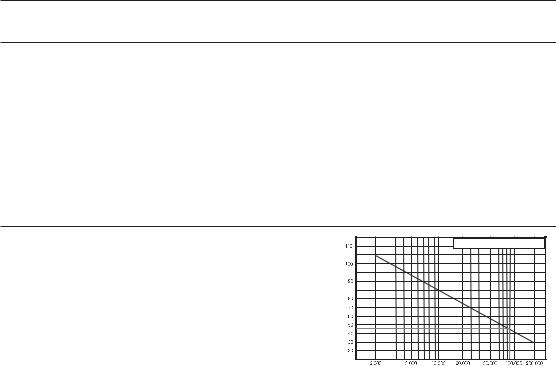
connecting with other device
INSTALLATION
Please take note of the followings before using this product.
•Do not use the product outdoor.
•Do not spill water or liquid in the connection part of the product.
•Do not impose the system to excessive shock or force.
•Do not pull out the power plug forcefully.
•Do not disassemble the product on your own.
•Do not exceed the rated input/output range.
•Use a certified power cord only.
•For the product with an input ground, use a grounded power plug.
CHECKING THE INSTALLATION ENVIRONMENT
Samsung Digital Video Recorder (“DVR” hereinafter) is a state-of-art security device, and contains mass storage hard disk(s) and critical circuits inside.
When the temperature rises inside the product, the product may breakdown and the product life be shortened.
Temperature |
One Year: 24HR X 365 DAY =8,760 HR |
Unit: ºC |
|
Life (Unit: HOURS)
12_ connecting with other device

CONNECTING THE VIDEO, AUDIO, AND MONITOR
1 |
2 |
|
AUDIO IN |
|
|
|
NETWORK |
|
|
|
|
ALARM OUT |
|||
|
|
|
|
|
|
DC 12 V |
|
|
|
|
|
VGA |
ALARM IN |
1 COM |
|
|
|
|
|
RS-485 |
|
||
|
|
|
|
1 |
2 3 4 G G |
+ |
CONSOLE |
3 |
4 |
|
|
|
|
|
|
|
|
|
|
|
|
||
|
VIDEO IN |
VIDEO OUT (SPOT) |
AUDIO OUT |
SERIAL |
|
|
USB |
|
|
|
|
M Only one mouse port is available.
CONNECTING THE USB
1.By factory default, a USB port is provided for external connection.
2.You can connect a USB HDD, USB memory or mouse to the USB port.
3.If a USB HDD is connected to the system, recognition and settings are available in “Menu > Setting the Device >
Storage Device”. (Page 40)
4.This product supports hot-plugging, which connects/removes the USB device during the system operation.
J If you use the USB device for Backup purposes, format it with FAT32 on PC if it is not formatted on the DVR.
CONNECTING POS DEVICE
1.You can connect a POS device to the RS-232C port on the product’s rear side when you connect it directly with a RS-232C cable.
2.Connection setup for the RS-232C port is available in “Menu > Device > POS Devices”, press the <POS Device Setup> button and set <Baudrate, Parity, Data, Stop bit and Transfer Type>. (Page 42)
DEVICE OTHER WITH CONNECTING
English _13

connecting with other device
CONNECTING THE ALARM INPUT/OUTPUT
Connecting the alarm input signal
Connection port for the alarm input signal.
Connect one strand of the sensor signal line to one of 4 strands of the alarm input port, and connect the other strand to the [G] port.
Connecting the alarm output signal
Connection port for the alarm output signal.
Connect one strand of the sensor signal line to the alarm output port and connect the other to the [COM] port.
•ALARM IN : 5mA sink
•ALARM OUT : 24V DC 1A, 125VAC/0.5A
CONSOLE
USB
SERIAL
|
|
ALARM OUT |
||
|
ALARM IN |
1 COM |
||
|
|
RS-485 |
||
|
1 2 3 4 G G |
+ |
|
|
|
|
|
|
|
|
|
|
|
|
|
|
|
|
|
CONNECTING THE RS-485 DEVICE
Connect the rear [RS-485 +, –] port to the PTZ camera or system keyboard.
MYou can connect and control the PTZ camera which supports the RS485 communication.
Check if the RS-485 device is compatible with the product first.
Pay attention not to change the polarity (+/-) of the RS-485 device when connecting it.
Depending on camera’s type, connection polarity can be different.
For further information, refer to the respective PTZ Camera’s documentation.
CONSOLE
USB
SERIAL
|
|
ALARM OUT |
||
|
ALARM IN |
1 COM |
||
|
|
RS-485 |
||
|
1 2 3 4 G G |
+ |
|
|
|
|
|
|
|
|
|
|
|
|
|
|
|
|
|
14_ connecting with other device

CONNECTING THE NETWORK
Connecting to Network through Ethernet (10/100BaseT)
1 |
2 |
|
AUDIO IN |
|
|
|
NETWORK |
|
|
|
|
ALARM OUT |
|||
|
|
|
|
|
|
DC 12 V |
|
|
|
|
|
VGA |
ALARM IN |
1 COM |
|
|
|
|
|
RS-485 |
|
||
|
|
|
|
1 |
2 3 4 G G |
+ |
CONSOLE |
3 |
4 |
|
|
|
|
|
|
|
|
|
|
|
|
||
|
VIDEO IN |
VIDEO OUT (SPOT) |
AUDIO OUT |
SERIAL |
|
|
USB |
|
|
|
|
RJ-45 Ethernet Cable
(Direct Cable)
NETWORK
Back Bone |
Hub/Switcher |
Hub/Switcher |
Windows |
Network Viewer |
Connecting to the Network using the router
1 |
AUDIO IN |
NETWORK |
2 |
||
|
ALARM OUT |
DC 12 V |
|
|
|
|
VGA |
|
ALARM IN |
|
1 COM |
|
|
|
|
2 |
G |
RS-485 |
||
|
|
|
|
1 |
3 4 G |
+ |
||
3 |
4 |
|
|
|
|
|
|
CONSOLE |
|
|
|
|
|
|
|
||
|
VIDEO IN |
VIDEO OUT (SPOT) |
AUDIO OUT |
SERIAL |
|
|
|
USB |
|
|
|
|
|
|
|
NETWORK |
Broadband Router |
xDSL or Cable |
xDSL or Cable |
Modem |
Modem |
External Remote PC
DDNS Server
(Data Center)
DEVICE OTHER WITH CONNECTING
English _15

connecting with other device
Connecting to Network through ADSL
1 |
2 |
|
AUDIO IN |
|
|
|
NETWORK |
|
|
|
|
ALARM OUT |
|||
|
|
|
|
|
|
DC 12 V |
|
|
|
|
|
VGA |
ALARM IN |
1 COM |
|
|
|
|
|
RS-485 |
|
||
|
|
|
|
1 |
2 3 4 G G |
+ |
CONSOLE |
3 |
4 |
|
|
|
|
|
|
|
|
|
|
|
|
||
|
VIDEO IN |
VIDEO OUT (SPOT) |
AUDIO OUT |
SERIAL |
|
|
USB |
|
|
|
|
RJ-45 Ethernet Cable
(Direct Cable)
NETWORK
Phone(ADSL) Line |
ADSL MODEM |
Hub/Switcher |
Windows |
Network Viewer |
16_ connecting with other device
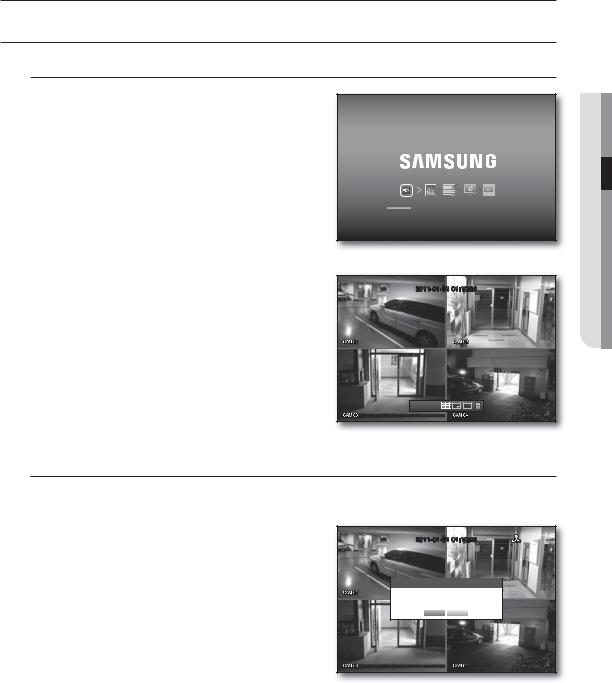
live
GETTING STARTED
Starting the system
1. Connect the power cable of the DVR to the wall outlet.
MIt takes about 10 seconds to display the start screen after booting.
2. You will see the initialization screen. |
|
|
|
|
|
The initialization process will last about 1 minute. |
|
|
|
|
|
If a new HDD is installed, the initialization process may |
|
|
|
REC |
|
|
|
|
|
|
|
take longer. |
|
|
|
|
|
3. The live screen appears with a beep.
2011-01-01 01:10:25
2011-01-01 01:10:25
Shutting Down the System
You can shut down the system only if you have logged into the DVR.
You require permission to shut down the system if you are not logged in as admin.
1. |
Press the [POWER] button on the remote control or |
2011-01-01 01:10:25 |
|
right-click to display the context sensitive menu and select |
|
2. |
<Shutdown>. |
|
The “Shutdown” confirmation window appears. |
Shutdown |
|
3. |
Use the arrow keys on the remote control to move to |
Are you sure to shutdown? |
OK Cancel |
||
|
<OK> and press the [ENTER] button or click <OK>. |
|
4. |
The system will shut down. |
|
Disconnecting the power cable for power off and |
|
|
|
reconnecting the power cable to restart. |
|
M For the permission management, refer to “Permission Management > Setting Permissions”. (Page 33)
LIVE
English _17
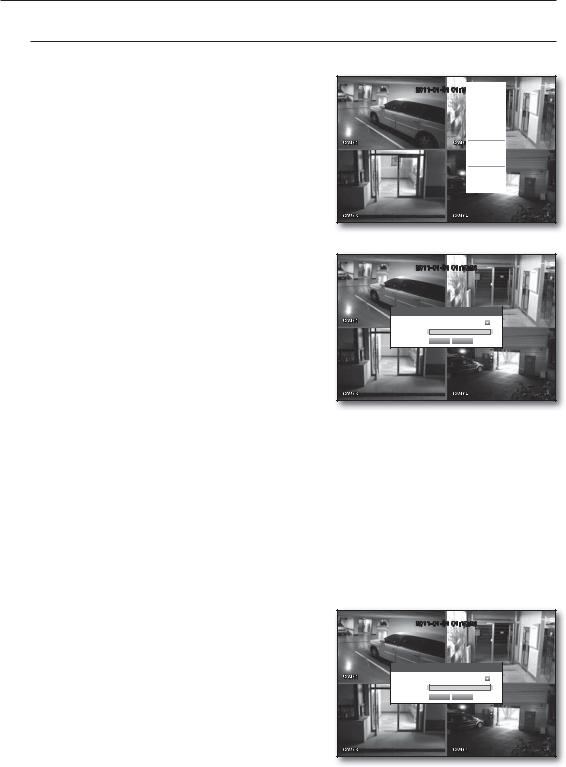
live
Login
To access a DVR or restricted menu, you should have logged in to the DVR.
1. In live mode, right-click any area of the screen. |
Scene Mode |
You will see the context sensitive menu as in the right |
2011-01-01 01:10:25Spot Out |
Audio Off |
|
figure. |
Freeze |
|
|
|
Stop Alarm |
|
Record |
|
Play |
|
Search |
|
Backup |
|
Main Menu |
|
Shutdown |
|
Hide Launcher |
|
Login |
2.Click <Login>.
The login dialog appears.
You can also see the login dialog to access a desired menu by pressing the [MENU] button on the remote control.
The login dialog will also appear if you press a menu button on the remote control of the DVR when the corresponding menu requires logging in.
After logged in, press [RETURN] on the remote control to display the logout dialog.
By default, initial ID and password are set to “admin”, and “4321”.
2011-01-01 01:10:25
Login
ID |
admin |
Password
OK Cancel
JThe default password can be exposed to a hacking thread so it is recommended to change the password after installing the product.
Note that the security and other related issues caused by the unchanged password shall be responsible for the user.
M For the restricted permission, refer to “Permission Management > Setting Permissions”. (Page 33)
Locking All Buttons
This will restrict access to all buttons available in the DVR.
1.In Live mode, press the remote control buttons in the order of [STOP (@)] [FREEZE] [STOP (@)] [FREEZE] [MENU].
2.In the lock condition, press any button to display a dialog where you are prompted to enter the password for unlocking the buttons.
The button lock will be released if you enter the admin password.
2011-01-01 01:10:25
Key Lock Password
ID |
admin |
Password
OK Cancel
18_ live

LIVE SCREEN CONFIGURATION
Icons on the Live Screen
You can check the status or operation of the DVR with the icons on the live screen.
2011-01-01 |
00:00:01 |
LIVE
CAM 01
|
|
|
|
|
|
|
|
|
|
|
|
|
|
|
|
|
|
|
|
|
|
|
|
|
|
|
|
|
|
|
|
|
|
|
|
|
|
|
|
|
|
|
|
|
|
|
|
|
|
|
|
|
|
|
|
|
|
|
|
|
|
|
|
|
|
|
Name |
Description |
|||||||||
|
|
Current Date, Time |
Displays the current time and date. |
|||||||||
b |
|
Login Information |
When you are logged in, the “LOG ON” icon will be displayed. |
|||||||||
|
|
|
|
|
|
|
|
|
|
|
|
Displayed if the zoom function is activated. |
|
|
|
|
|
|
|
|
|
|
|
|
Displayed if you press the Pause button. |
c |
Screen Mode |
|
|
|
|
|
|
|
Displayed in Auto Sequence mode where all channels are switched at the |
|||
|
|
|
|
|
|
|
specific time interval. |
|||||
|
|
|
|
|
|
|
||||||
|
|
|
|
|
|
|
|
|
|
|
|
This icon is displayed if a user with restricted access to the Record button tries |
|
|
|
|
|
|
|
|
|
|
|
|
to make manual recording. |
|
|
|
|
|
|
|
|
|
|
|
|
|
|
|
|
|
|
|
|
|
|
|
|
|
Only the user with the applicable permission can release (stop) the recording. |
|
|
|
|
|
|
|
|
|
|
|
|
Displayed if the HDD is full and the DVR has an insufficient space to record. |
|
|
|
|
|
|
|
|
|
|
|
|
|
|
|
|
|
|
|
|
|
|
|
|
|
|
|
|
|
|
|
|
|
|
|
|
|
|
|
|
System Operation |
|
|
|
|
|
|
|
Displayed if no HDD is installed or the existing HDD should be replaced. |
|||
|
|
|
|
|
|
|
|
|||||
|
|
|
|
|
|
|
|
|||||
|
|
|
|
|
|
|
|
Displayed if the HDD needs a technical examination. |
||||
|
|
|
|
|
|
|
||||||
|
|
|
|
|
|
|
||||||
|
|
|
|
|
|
|
|
|
|
|
|
Displayed while the backup is in process or if the backup data is played. |
|
|
|
|
|
|
|
|
|
|
|
|
Displayed if the firmware can be updated via the network. |
|
|
|
|
|
|
|
|
|
|
|
|
|
|
|
|
|
|
|
|
|
|
|
|
|
|
|
Video Input Status |
|
|
|
|
|
|
|
Displayed if no input is entered in the condition that the camera is set to <ON>. |
|||
|
|
|
|
|
|
|
Nothing will be displayed on the screen if the camera is set to <OFF>. |
|||||
|
|
|
|
|
|
|
|
|
|
|
|
|
|
Camera Name/ Channel |
Displays the camera name and the changed channel, if any. |
||||||||||
|
|
|
|
|
|
|
|
|
|
|
|
Displays the resolution of the recording screen. (Page 47) |
|
|
|
|
|
|
|
|
|
|
|
|
|
|
|
|
|
|
|
|
|
|
|
|
|
|
|
|
|
|
|
|
|
|
|
|
|
|
Displayed in PTZ setting, and highlighted yellow if PTZ is in operation. |
|
|
|
|
|
|
|
|
|
|
|
|
Displays AUDIO ON/MUTE. |
|
Camera Operation |
|
|
|
|
|
|
|
Not displayed in video mode if deactivated. |
|||
|
|
|
|
|
|
|
If the sensor is set to <ON>, the input signal will be displayed on the screen of |
|||||
|
|
|
|
|
|
|
|
|
|
|
|
the connected channel. |
|
|
|
|
|
|
|
|
|
|
|
|
|
|
|
|
|
|
|
|
|
|
|
|
|
Displayed if a motion detected in the condition that the motion detection is set to |
|
|
|
|
|
|
|
|
|
|
|
|
|
|
|
|
|
|
|
|
|
|
|
|
|
<ON>. |
|
|
|
|
|
|
|
|
|
|
|
|
Displays the current record mode from Record/Event/Schedule. |
English _19
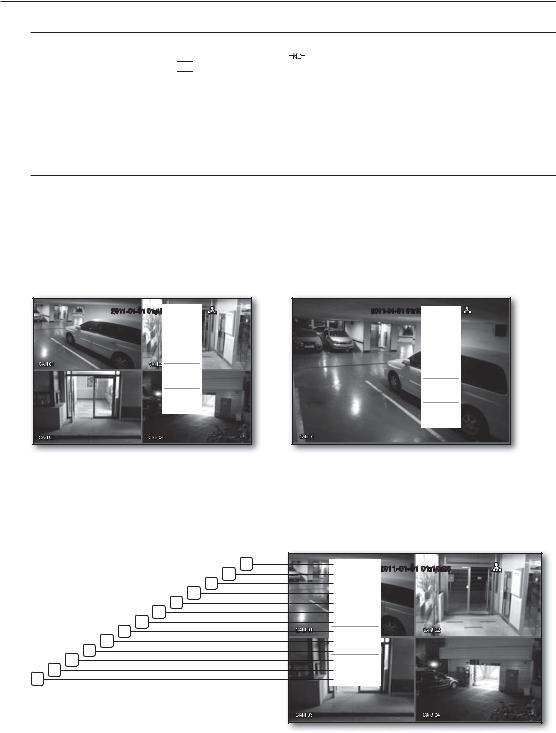
live
Error Information
•If the internal HDD is not connected, the “NO HDD”(  ) message will appear; if there occurs a problem,
) message will appear; if there occurs a problem,
you will see the “HDD FAIL”(  ) message in the top left corner. In this case, make sure you contact the service center for assistance as this may cause a failure of recording, playback or backup.
) message in the top left corner. In this case, make sure you contact the service center for assistance as this may cause a failure of recording, playback or backup.
M If you see the No HDD, HDD FAIL icons on the screen, contact the service center for more details.
Live Screen Menu
In addition to the buttons the remote control, you can access a desired menu by right-clicking the mouse any area in live mode.
The context sensitive menu that appears by right-clicking the screen may differ, depending on the login/logout, screen split mode and DVR operation mode.
M Menu items of Search, Record, Backup, Shutdown can be deactivated, depending on the user permission.
Scene Mode |
|
Scene Mode |
|
2011-01-01 01:10:25Spot Out |
|
||
|
2011-01-01 01:10:25 |
|
|
Audio Off |
|
Spot Out |
|
|
PTZ Control |
|
|
|
|
|
|
Freeze |
|
Zoom In |
|
|
|
|
|
Stop Alarm |
|
Audio |
|
Record |
|
Freeze |
|
Play |
|
Stop Alarm |
|
Search |
|
Record |
|
Backup |
|
Play |
|
Main Menu |
|
Search |
|
Shutdown |
|
Backup |
|
Hide Launcher |
Main Menu |
|
|
Logout |
|
Shutdown |
|
|
Hide Launcher |
||
|
|
||
|
|
Logout |
|
< Split Mode Menu > < Single Mode Menu >
Split Mode Menu
The context sensitive menu in split mode differs, depending on the login/logout status.
1 |
Scene Mode |
2011-01-01 01:10:25 |
|
Spot Out |
|
||
2 |
Audio Off |
|
|
3 |
Freeze |
|
|
4 |
Stop Alarm |
|
|
5 |
Record |
|
|
6 |
Play |
|
|
7 |
Search |
|
|
8 |
Backup |
|
|
9 |
Main Menu |
|
|
10 |
Shutdown |
|
|
11 |
Hide Launcher |
|
|
12 |
Logout |
|
|
13 |
|
|
|
20_ live
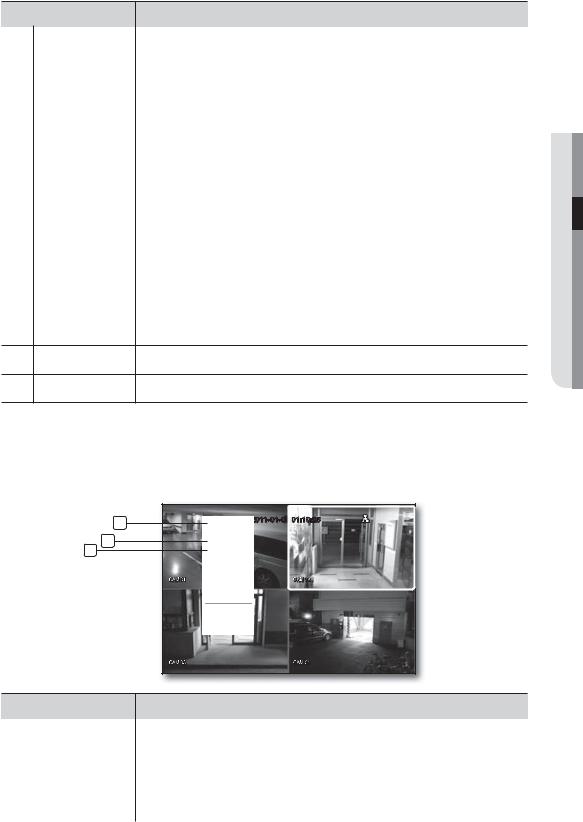
Menu |
Description |
Scene Mode |
Refer to “Live Mode”. (Page 23) |
b Spot Out |
Refer to “Spot Out”. (Page 25) |
c Audio On/Off |
Refer to “Audio ON/OFF”. (Page 26) |
Freeze |
Refer to “Freeze”. (Page 26) |
Stop Alarm |
Stop the alarm output, deactivate the event icon and release the auto sequencing. |
Refer to “Event Monitoring”. (Page 26) |
|
Record/Stop |
Starts/stops the standard recording. |
Play |
Refer to “Search & Play > Play”. (Page 65) |
Search |
Refer to “Search & Play > Search”. (Page 62) |
Backup |
Refer to “Using the DVR > Setting the Backup”. (Page 52) |
Main Menu |
Accesses the main menu. Refer to the Using the DVR section. (Page 28) |
Shutdown |
Turns down the DVR. |
Show/Hide Launcher Shows or hides the launcher. Refer to “View the Launcher Menu”. (Page 22)
m Login/Logout |
You can log in or out. |
Single Mode Menu
The single mode menu is available only in Single Mode.
The context sensitive menu for the One Channel mode, in Split mode is different from that of the Single mode.
1 |
Full Screen |
2011-01-01 01:10:25 |
Spot Out |
|
|
2 |
PTZ Control |
|
Zoom In |
|
|
3 |
Audio |
|
|
Freeze |
|
|
Stop Alarm |
|
|
Record |
|
|
Play |
|
|
Shutdown |
|
|
Hide Launcher |
|
|
Logout |
|
Menu |
|
Description |
|
Full Screen |
Select and click a desired channel in Split mode to switch to the full screen of the selected |
channel. |
||
b |
PTZ Control |
Accesses the PTZ Control menu. |
The PTZ menu will be active on Live screen if you select a single channel. (Page 60) |
||
c |
Zoom In |
Enlarges the selected image. (Page 25) |
LIVE
English _21
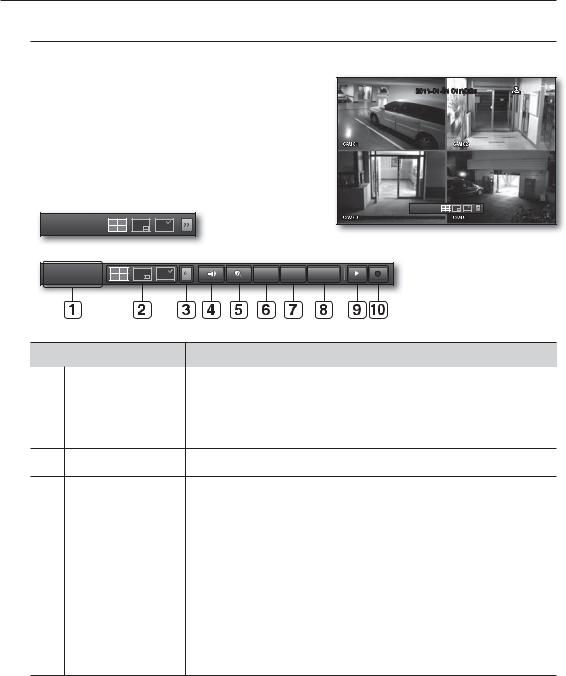
live
View the Launcher Menu
The Launcher menu appears on the bottom of the live screen.
1.In Live mode, right-click to display the context menu and select <Show Launcher>.
2.Move the cursor to the bottom and click a desired item in the Launcher menu.
MIf no input is entered for 10 seconds, the menu will disappear.
The Launcher menu can be accessed only by using the mouse.
2011-01-01 01:10:25
2011-01-01 01:10:25
2011-01-01 01:10:25
2011-01-01 |
PTZ Alarm Freeze |
01:10:25 |
|
Menu |
Description |
Date/Time |
Displays the current time and date. |
The indication of AM/PM is displayed if you set 12 hours for the time format in |
|
|
“System > Date/Time/Language > Time”. (Page 28) |
b Screen Mode |
Press this button to switch the screen mode in sequence. |
cMenu Expansion Button Click to display the hidden menu to the right.
Audio |
Turns ON/MUTE the sound of the selected channel. |
Zoom |
Enlarges the selected area. This is available only in Single Live mode. |
PTZ |
Runs the PTZ Control launcher. |
Alarm |
Stops the alarm if it's activated. |
Freeze |
Freezes the Live screen temporarily. |
Play |
Enters Play mode if a file to play exist, and if not, enters Search mode. |
Record |
Start/End recording the Live screen. |
22_ live
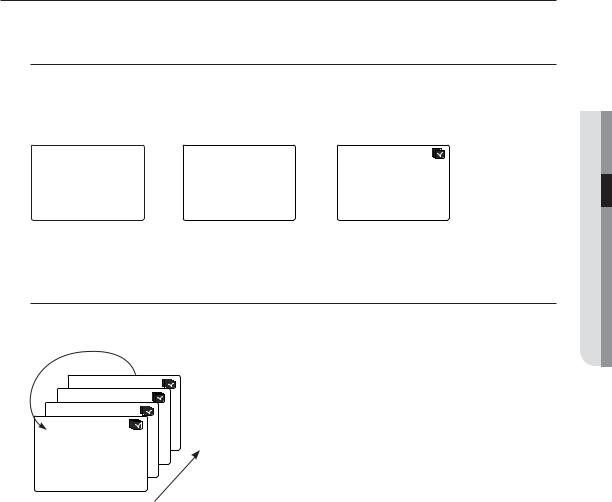
LIVE MODE
Displays 4 live video images in 3 different modes.
Switching the screen mode
To switch the split mode, select a screen mode in the launcher menu, or right-click to select a screen mode in the context menu.
Press the [MODE] button on the remote control to switch the mode in the sequence of the launcher menu items.
CH1 |
|
CH2 |
|
|
|
|
|
|
|
||
|
|
|
|
|
|
CH3 |
|
CH4 |
CH1 |
CH2 |
CH1 |
|
4-split |
mode |
PIP |
|
Auto Sequence |
Switching the screen automatically
With SRD-440 you can display 4 live single screens in sequence.
LIVE
CH1 |
4 |
CH1 |
|
CH1 |
|
CH1 |
|
Single mode |
1 |
MIn Single mode, If you have set <SEQ-Dwell Time> in “Setting the Device > Camera”, Auto Sequence will be conducted at the set interval. (Page 38)
English _23

live
Channel Setting
You can display the channel in a desired area of a split screen.
1.Click a camera name to display a channel list where you can select a different channel.
2.Select a desired channel and click it.
The current channel will be switched to the selected one.
Use the cursor to select a channel to move, and drag and drop it to a desired channel; this can also change the channel position.
Ex : if switching CH 1 to CH 4
CH1 |
CH2 |
|
CH4 |
CH2 |
|
|
|
CH3 |
CH1 |
CH3 |
CH4 |
|
||
|
|
|
|
|
Switching to Single Mode
When in split mode, select and double-click a desired channel to switch to its Single mode.
Press the number corresponding to a desired channel the remote control to switch to its Single mode. Refer to “Remote Control > Using the numeric buttons”. (Page 11)
Ex : If double-clicking CH 3 or pressing the number “3” on the remote control.
CH1 |
CH2 |
|
|
||
CH3 |
CH4 |
CH3 |
24_ live
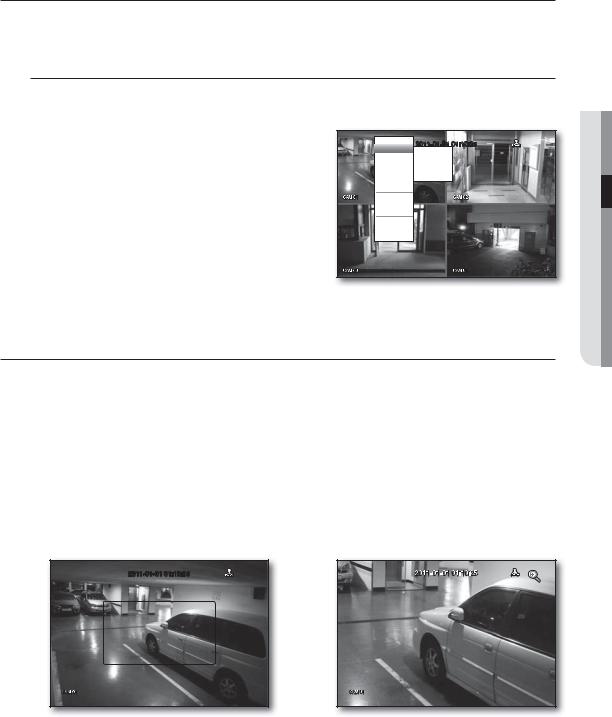
SPOT OUT
The Spot Out monitoring is independent of the Live mode, which monitors a specific channel through the Spot Out port.
Selecting a Spot Out mode
If an event occurs such as sensor, motion or alarm from the Spot Out port in connection with a monitor, you can select a output screen mode.
1.In Live mode, right-click any area on the screen. The Live menu appears.
2.Click <Spot Out>.
Supports the Spot output in Single screen with Auto Sequence mode.
If the monitor is connected to the Spot port, the event that occurred from the selected channel will be output on the monitor.
For the Spot Out port of a model, refer to “Part Names and
Functions (Rear)”. (Page 10)
Scene Mode |
|
2011Auto Sequence-01-01 01:10:25 |
Spot Out |
|
|
Audio Off |
|
CH1 |
Freeze |
|
CH2 |
Stop Alarm |
|
CH3 |
Record |
|
CH4 |
|
|
Play
Search
Backup
Main Menu
Shutdown
Hide Launcher
Logout
< Multichannel Live Menu >
ZOOM
This is available only in Single Live mode. In Single mode, select a desired area and use the Zoom function to enlarge it twice.
1.Select <Zoom In> in the right-click menu.
Press the [ZOOM] button on the remote control, or simply click <  > in the launcher menu. The zoom box appears.
> in the launcher menu. The zoom box appears.
2.Use the direction keys, or drag and drop to specify an area to enlarge.
3.Press the [ENTER] button, or double-click the selected area to enlarge it twice.
In the enlarged image, use the direction buttons (◄ ►) on the remote controlto move the enlarged area.
4.Press the [ZOOM] button on the remote control, or simply click <  > in the launcher menu to release the zoom.
> in the launcher menu to release the zoom.
2011-01-01 01:10:25
LIVE
English _25

live
AUDIO ON/OFF
You can turn the sound on/off the CH1 in Live mode.
AUDIO ON/OFF in Single mode
Click the audio icon (
 ) on the screen, or press the [AUDIO] button on the remote control to turn it on/off.
) on the screen, or press the [AUDIO] button on the remote control to turn it on/off.
MOnly the channel where <AUDIO> is set to <ON> in “Device > Camera” displays the audio icon (
 ) in Live mode that you can use to turn the sound on/off.
) in Live mode that you can use to turn the sound on/off.
FREEZE
This is available only in Live mode, this pauses playing the Live image temporarily.
1. Press the [FREEZE] button the remote control, or click < Freeze > in the launcher menu. The playback of the image is stopped temporarily.
2.Press the [FREEZE] button again, or click < Freeze >. This will release the freeze.
EVENT MONITORING
This will display the channel in sync with a specific event (Sensor/Motion/Video Loss) if it occurs.
In “Monitor > Event Display”, set the event monitoring to ON/OFF and specify the event display time. (Page 44)
•If multiple events occur simultaneously, the screen will switch to a split mode. - 2~4 events : 4-split mode
•If the second event occurs within the set time of <Event Display>, the first event will last until the second one is terminated. (Page 44)
Ex : If you set <Event Display> to 5 seconds, and only one event occurs in CH 1.
Event occurrence |
5 seconds |
|||
|
|
|
|
|
|
|
|
|
|
Stop alarm
CH1
26_ live
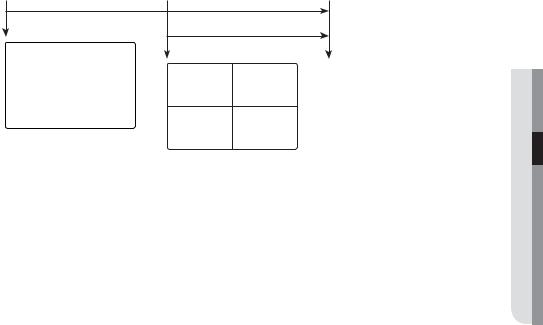
Ex : If you set <Event Display> to 5 seconds, and the second event occurs in CH 2 within the set time after the first event occurred in CH 1.
Event occurrence |
4 seconds |
9 seconds |
Stop alarm
CH1 |
CH2 |
CH1
MPress the [ALARM] button to reset the alarm settings and to release the event mode.
If an alarm activates in the condition you have set the event record, and pre/post alarm times, the event record will be performed.
LIVE
English _27

using the DVR
You can setup the system properties, devices, and options for recording, event, backup and network.
SYSTEM SETUP
You can setup Date/Time/Language, Permission, System Properties and Log.
Date/Time/Language
You can check and setup the current Date/Time and time related properties, as well as the language used for the interface on the screen.
Setting the Date/Time/Language
Set the Date/Time/Language
Using the mouse may help make setup easier.
1. Press the [MENU] button on the remote control.
2011-01-01 01:10:25
If not logged in, it prompts with login window. Refer to “Login”. (Page 18)
2011-01-01 01:10:25
2. Use the left/right buttons (◄ ►) to select the <System>. |
|
|
|
|
|
|
|
|
|
|
|
|
|
|
|
|
|
|
|
|
|
|
|
|
|
|
|
|
|
|
|
|
|
Logout |
|
|
|
Return |
|
|
|||
System property setup menu is selected. |
|
|
|
|
|
|
|
|
|
|
|
|
|
|
|
|
|
|
|
|
|
|
|
|
|
|
|
|
|
|
|
|
|
|
|
|
|
|
|
|
|
|
|
3. Use the up/down buttons ( ) to select <Date/Time/ |
|
|
|
|
|
|
|
|
|
|
|
|
|
|
|
|
|
|
|
|
|
|
|
|
|
|
|
|
|
|
|
|
|
|
|
|
|
|
|
|
|
|
|
|
|
|
|
|
|
|
|
|
|
|
|
|
|
|
|
|
|
|
|
|
|
Language> and press the [ENTER] button. |
|
|
System |
|
|
|
|
|
|
|
|
|
|
|
|||||||
4. Select <Date/Time/Language>. |
|
|
|
|
Date/Time/Language |
|
|
|
|
|
|||||||||||
A dialog to setup Date, Time and Language. |
|
|
|
|
Permission Management |
|
|
|
|
|
|||||||||||
|
|
|
|
|
|
|
|
|
|
||||||||||||
5. Use direction buttons (◄ ►) to select an item to set |
|
|
|
|
System Management |
|
|
|
|
|
|||||||||||
|
|
|
|
Log Information |
|
|
|
|
|
|
|
|
|
|
|
||||||
and make your changes. |
|
|
|
|
|
|
|
|
|
|
|
|
|
|
|
|
|
|
|
|
|
• Date : Sets the date that will appear on the screen. |
|
|
|
|
|
|
|
|
|
|
|
|
|
|
|
|
|
|
|
|
|
|
|
|
|
|
|
|
|
|
|
|
|
|
|
|
|
|
|
||||
|
|
|
|
|
|
|
|
|
|
|
|
|
|
|
|
|
|
|
|
|
|
|
|
Date/Time/Language |
|
|
|
|
|
|
|
|
|
|
|
||||||||
You can select the date format. |
|
|
|
|
|
|
|
|
|
|
|
|
|
|
|
|
|
|
|||
|
Date/Time/Language |
|
Holiday |
|
|
|
|
|
|
|
|
|
|
|
|||||||
• Time : Sets the time and its format that will appear on the |
|
|
|
|
|
|
|
|
|
|
|
|
|
|
|
|
|
|
|||
|
|
Date |
|
2011-01-01 |
|
|
YYYY-MM-DD |
|
|
|
|
|
|
|
|||||||
screen. |
|
|
|
|
|
|
|
|
|
|
|
|
|
|
|
|
|
|
|
|
|
|
|
|
|
|
|
|
|
|
|
|
|
|
|
|
|
|
|
|
|
|
|
|
|
|
|
|
|
|
|
|
|
|
|
|
|
|
|
|
|
|
|
|
|
Select either one from <24 Hours, 12 Hours (AM/PM)>. |
|
|
Time Zone |
|
GMT |
|
|
|
|
|
|
|
|
|
|
|
|||||
|
|
|
Time |
|
08:14:24 |
|
|
|
24 Hours |
|
|
|
|
|
|
||||||
• Time Zone : Sets the time zone of your area based on the |
|
|
DST |
|
|
Dec First (Sun) 0 |
|
|
Dec First (Sun) 0 |
|
|
|
|
|
|||||||
|
|
|
Time Sync. |
|
Setup |
|
|
|
|
|
|
|
|
|
|
|
|||||
Greenwich Mean Time (GMT). |
|
|
|
|
|
|
|
|
|
|
|
|
|
|
|
|
|
|
|
|
|
|
|
|
|
|
|
|
|
|
|
|
|
|
|
|
|
|
|
|
|
|
|
|
|
|
|
|
|
|
|
|
|
|
|
|
|
|
|
|
|
|
|
|
|
|
|
|
|
|
|
|
|
|
|
|
|
|
|
|
|
|
|
|
|
|
|
GMT (Greenwich Mean Time) is standard World Time and the basis |
|
|
Language |
|
English |
|
|
|
|
|
|
|
|
|
|
|
|
|
|||
|
|
|
|
|
|
|
|
|
|
|
|
|
|
|
|
|
|
|
|
|
|
|
|
|
|
|
|
|
|
|
|
|
|
|
|
|
|
|
|
|
|
|
|
of world time zone. |
|
|
|
|
|
|
|
|
|
|
|
|
|
|
|
|
|
|
|
|
|
|
|
|
|
|
|
|
|
OK |
Cancel |
|
|
|
|
|
|||||||
|
|
|
|
|
|
|
|
|
|
|
|
|
|
||||||||
|
|
|
|
|
|
|
|
|
|
|
|
|
|
|
|
|
|
|
|
|
|
•Time Sync. : You can set the DVR’s current time
synchronized to a selected <Time Server> regularly if you select to use <Time Server>. In this case, <Date/Time/Language> setup does not allow time adjustment.
28_ using the DVR
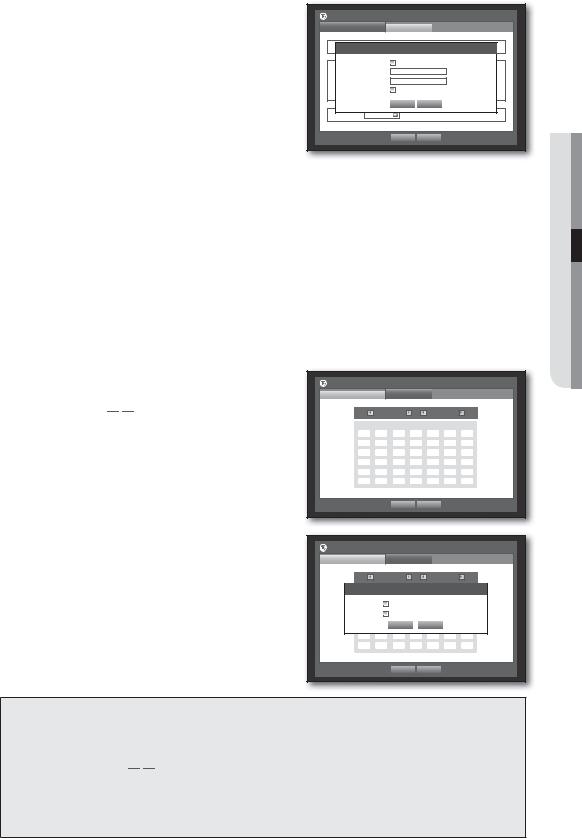
- Time Server : Enter an IP or URL address of the time |
Date/Time/Language |
|
|||||
- |
server. |
Date/Time/Language |
|
Holiday |
|
||
Last Sync Time : Displays the most recent |
Date |
2011 -01-01 |
|
YYYY-MM-DD |
|||
|
synchronization time from the selected time server. |
Time Synchronization Setup |
|||||
- |
Activate as Server : Set to <Use> to allow the DVR to act |
Synchronization |
|
Use |
24 Hours |
||
Time Zone |
GMT+08:00 |
|
|||||
|
as a Time Server for other DVRs. |
Time |
08:14:24 |
|
|
||
|
Time Server |
|
203.248.240.103 |
||||
|
Time Sync. |
Setup |
Not Used |
Fail |
|||
• DST : Set up Daylight Saving Time with its period to make |
Last Sync Time |
|
|
||||
Activate as Server |
|
Use |
|
||||
DST |
Dec First (Sun) 0H |
Dec First (Sun) 0H |
|||||
|
|
||||||
the time earlier than the GMT of its time zone by 1 hour |
|
|
|
OK |
Cancel |
||
Language |
English |
|
|
|
|||
during the set period. |
|
|
|
|
|
||
• Language : Select your language. Sets the language for the interface.
English, French, German, Spanish, Italian, Chinese, Russian, Korean, Polish, Japanese, Dutch, Portuguese, Turkish, Czech, Danish, Swedish, Thai, Romanian, Serbian, Croatian, Hungarian and Greek are available.
6. When the Date/Time/Language setup is done, press <OK>.
M You can also use numeric buttons on the remote control to enter values for Date, Time and other numeric fields.
Setting Holiday
You can set specific dates to Holidays according to your preferences.
Holidays are applied to <Recording Schedule> and <Alarm Schedule> too.
Using the mouse may help make setup easier.
1.Use the up/down buttons ( ) in <Date/Time/Language> window to select <Date/Time/Language>, and press the [ENTER] button.
2.Select <Holiday>.
A calendar for Holiday setup appears.
3.Use the left/right < 




 > buttons to select year or month, and press the [ENTER] button.
> buttons to select year or month, and press the [ENTER] button.
4.Use direction buttons (◄ ►) to select a desired date, and press the [ENTER] button.
You will see the “Setting Holiday” screen.
Ex : Select January 10th and check on <1/10> only to make every January 10th a holiday. Check both on <1/10> and <Jan 2nd Mon> to make every January 10th and 2nd Monday of January holidays.
5.When the Holiday setup is done, press <OK>.
Date/Time/Language |
|
|
|
|
||
Date/Time/Language |
Holiday |
|
|
|
||
|
2011 |
|
|
Jan |
|
|
Sun |
Mon |
Tue |
Wed |
Thu |
Fri |
Sat |
|
|
|
|
|
|
1 |
2 |
3 |
4 |
5 |
6 |
7 |
8 |
9 |
10 |
11 |
12 |
13 |
14 |
15 |
16 |
17 |
18 |
19 |
20 |
21 |
22 |
23 |
24 |
25 |
26 |
27 |
28 |
29 |
30 |
31 |
|
|
|
|
|
|
|
OK |
|
Cancel |
|
|
Date/Time/Language |
|
|
|
|
|||
Date/Time/Language |
|
Holiday |
|
|
|
||
|
2011 |
|
|
Jan |
|
||
SettingSun HolidayMon Tue |
Wed |
Thu |
Fri |
Sat |
|||
|
|
1 / 10 |
|
|
|
1 |
|
2 |
3 |
5 |
6 |
7 |
8 |
||
4 |
|||||||
9 |
10 |
Jan 2nd Mon |
13 |
14 |
15 |
||
11 |
12 |
||||||
16 |
17 |
OK |
19 |
Cancel |
21 |
22 |
|
18 |
20 |
||||||
23 |
24 |
25 |
26 |
27 |
28 |
29 |
|
30 |
31 |
|
|
|
|
|
|
|
|
OK |
|
Cancel |
|
|
|
Using the Calendar
Using the mouse may help make setup easier.
Select year and month.
Select the left/right < 
 > key on the left/right side of year/month and press [ENTER] button to adjust by 1 year/month.
> key on the left/right side of year/month and press [ENTER] button to adjust by 1 year/month.
Use direction buttons to select a date and press [ENTER] button.
A date with recorded data to be searched will appear in yellow in the System Log, Event Log, Time Search and Event Search.
DVR THE USING
English _29
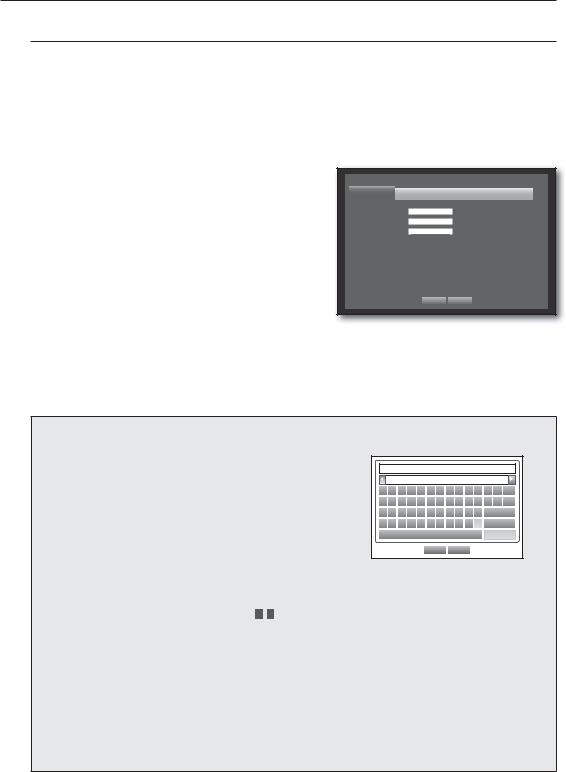
using the DVR
Permission Management
You can set permissions of each user over the DVR's specific function and settings.
Setting the Administrator
You can set and change Administrator’s ID and password.
The administrator can use and set all menu items and functions.
Using the mouse may help make setup easier.
1.Use the up/down buttons ( ) in <System> window to move to <Permission Management>, and press [ENTER] button.
2.Select <Admin>.
A dialog for Admin ID and Password input appears.
3.Use direction buttons (◄ ►) to move to a desired item, and set the ID and password.
MBy default, initial ID and password are set to “admin”, and “4321”.
 Permission Management
Permission Management
|
Admin |
Group |
|
User |
Setup |
||
|
|
|
|
|
|
|
|
|
ID |
|
admin |
|
|
|
|
|
New Password |
|
|
|
|
|
|
|
|
************ |
|
|
|
|
|
|
Confirm P/W |
|
|
|
|
|
|
|
|
************ |
|
|
|
|
|
|
|
|
|
|
|
|
|
|
|
|
|
|
|
|
|
OK Cancel
The default password can be exposed to a hacking thread so it is recommended to change the password after installing the product.
Note that the security and other related issues caused by the unchanged password shall be responsible for the user.
4.When the administrator setup is done, press <OK>.
Using Virtual Keyboard
For alphanumeric inputs, the virtual keyboard window appears.
Use direction buttons (◄ ►) to move to a desired character, and press the [ENTER] button.
In the upper text input box of the virtual keyboard, there displays a list of candidate words containing the selected character.
` 1 |
2 |
3 |
4 |
5 |
6 |
7 |
8 |
9 0 - = |
|||||
q |
w |
e |
r |
t |
y |
u |
i |
o |
p |
[ |
] |
\ |
Del |
a |
s |
d |
f |
g |
h |
j |
k |
l |
; |
‘ |
Caps Lock |
||
z |
x |
c |
v |
b |
n |
m |
, |
. |
/ |
|
|
Shift |
|
|
|
|
|
|
Space |
|
|
|
|
|
|
Ctrl |
|
|
|
|
|
|
OK |
|
|
Cancel |
|
|
|
|
|
Select a word from the list, or use the keyboard to enter the whole word.
If there are many of candidate words, use <  ,
,  > buttons to move between them forward and backward.
> buttons to move between them forward and backward.
Select <OK>.
Entered word is applied.
For upper case letters, use <Caps Lock> button.
For special characters, use <Shift> button.
Using the virtual keyboard is the same to a normal keyboard use in your region.
You can enter the ID with case-insensitive alphanumeric characters only.
For the password, use alphabets and special characters excluding < \ > and <“>.
You can use number buttons on the remote control.
30_ using the DVR
